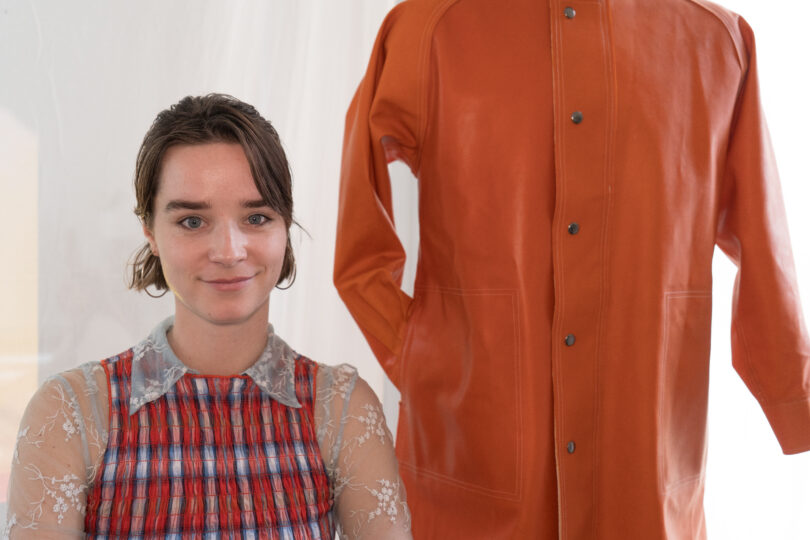Copenhagen, DENMARK – Under the soft lights in the loft of Sankt Nikolaj Kirke, an 11th-century church now operating as an art hall, climate activist Emma Hakansson unveiled a new collaboration between indigenous Amazon people and a textile laboratory in Peru – a luxury bio-leather called Shiringa.
Listen to the author read this story:
Hakansson, an Australian filmmaker who founded Collective Fashion Justice, a charity that promotes what she coined ”total ethics fashion,” presented Shiringa at the Creative Hub during Copenhagen Fashion Week.
At the Creative Hub last week, Hakansson shared a short documentary she made about the partnership between the Awajún people, an indigenous group in Peru, and Caxacori Studio, the textile company in Lima. The collaboration includes international designers, including Marimekko, Mozhdeh Matin, AERON, ASK Scandinavia, and Serena Coelho.
The film takes viewers from the source to the final product. It begins in the Amazon forest, where the Awajún people use a tool to cut a few millimeters into the shiringa tree until sap becomes accessible. Tapping is slow, generating 150-200 ml, or around 5 to 6.5 ounces every 48 hours.
Over a tree’s life, around 3,400 litres, or about 900 gallons, can be extracted from the tree without affecting the life of the tree, according to information provided by Collective Fashion Justice.
The finished product is a type of natural rubber that differs from imitation leather and rubber in appearance and feel due to its woven base. Rather than pouring the sap into a mold as typically happens with rubber products, the Caxacori Studio weaves it into pieces.
According to Hakansson, the indigenous Awajún people are the stewards of the project and are in charge, with decisions made according to their terms. She said she has refused to allow designers to take out patents on Shiringa.
Hakansson spoke about the conservation agreement that she has with the Awajún people. She said it allows the Awajún to have demands met in order for them to even hand over the sap for the Shiringa that they source.
It is the Awajún, Hakansson said, who determine the payment structure, the time in which they source the material.
The indigenous group also has other demands met, according to Hakansson.
Sourcing this material for Shiringa, “wouldn’t happen otherwise,” Hakansson said.
Local South American designers have been using the sap for years, by taking native cotton and covering it in layers of the sap, according to information provided by Collective Fashion Justice. With every coat, the bond becomes stronger and stiffer. This artisan process has been done entirely by the indigenous community, creating jobs and income.
The Awajún people know best how much tapping the trees can take and when they need a rest, the information from Collective Fashion Justice said.

In the film, the indigenous people explain the process of tapping the trees.
But the traditional product may not be compatible with all brands or in larger production.
Enter Caxacori Studio, the textile lab in the heart of Peru’s capital, Lima, which is now helping to bring Shiringa to the international market.
Caxacori Studio has developed an alternative way of production solely using mechanical equipment. The lab chose to use mechanical equipment to have more control of the thickness and color of the clothing or accessories.
The lab uses a water-based polyurethane as an additive to create more strength in the material, the Collective Fashion Justice materials said. The strongest version of the product includes 25 percent polyurethane, which is used on products that need more durability.
Another major difference in production is the fact that the lab purifies the latex, which, among other things, ensures the quality and shelf life of pieces.

The texture of the studio’s bio-leather when used on products feels somewhere between a rubber and a leather. Because it is woven, it does not have a layer of plastic on top that is often found on fake leathers. These top layers can peel from use, causing some unpleasant wear and tear and contributing to problem of global fashion disposal.
The way Shiringa feels to the touch is hard to describe, as it doesn’t feel like traditional leather or like rubber, more like something in between.
The flexural strength of the product is measured by determining how many times it can be bent before it cracks. This measurement, also known as the fracture strength – of a piece of bio leather with 87 percent bio-based content, has a strength of around 125,000 cycles, which means it can be bent 125,000 times before it cracks. That’s around 2.5 times more than the average piece of cow leather, according to independent testing by Instituto Tecnológico de la Producción, which was provided by Collective Fashion Justice.
That means the product may be more durable in the long run, with, for example, jackets that are often bent and worn quite quickly.
Shiringa is and will most probably stay a luxury material Hakansson said, because it cannot be produced in massive quantities in its current form.
As of February this year, Caxacori Studio can produce 600 square metres, around 6,500 square feet, every month, according to Collective Fashion Justice.
The current square metre cost of a 1 x 0.5 metre sheet is $33, but Collective Fashion Justice said that with increased investment, the Caxacori Studio could buy the sap from more indigenous communities, as shiringa trees grow across the Amazon. It would then be possible to improve the lab’s capacity, increase sheet size and decrease price at scale.
Through developing the Shiringa partnership Hakansson has helped create artisanal jobs and drawn attention in the fashion world to the world’s ever-growing climate emergency – all while leaving the shiringa trees standing.
Noah Haynes is a Correspondent with Youth Journalism International. He reported and wrote this story.
Jana Salama is a Reporter with Youth Journalism International from Egypt. She contributed reporting for this story.



